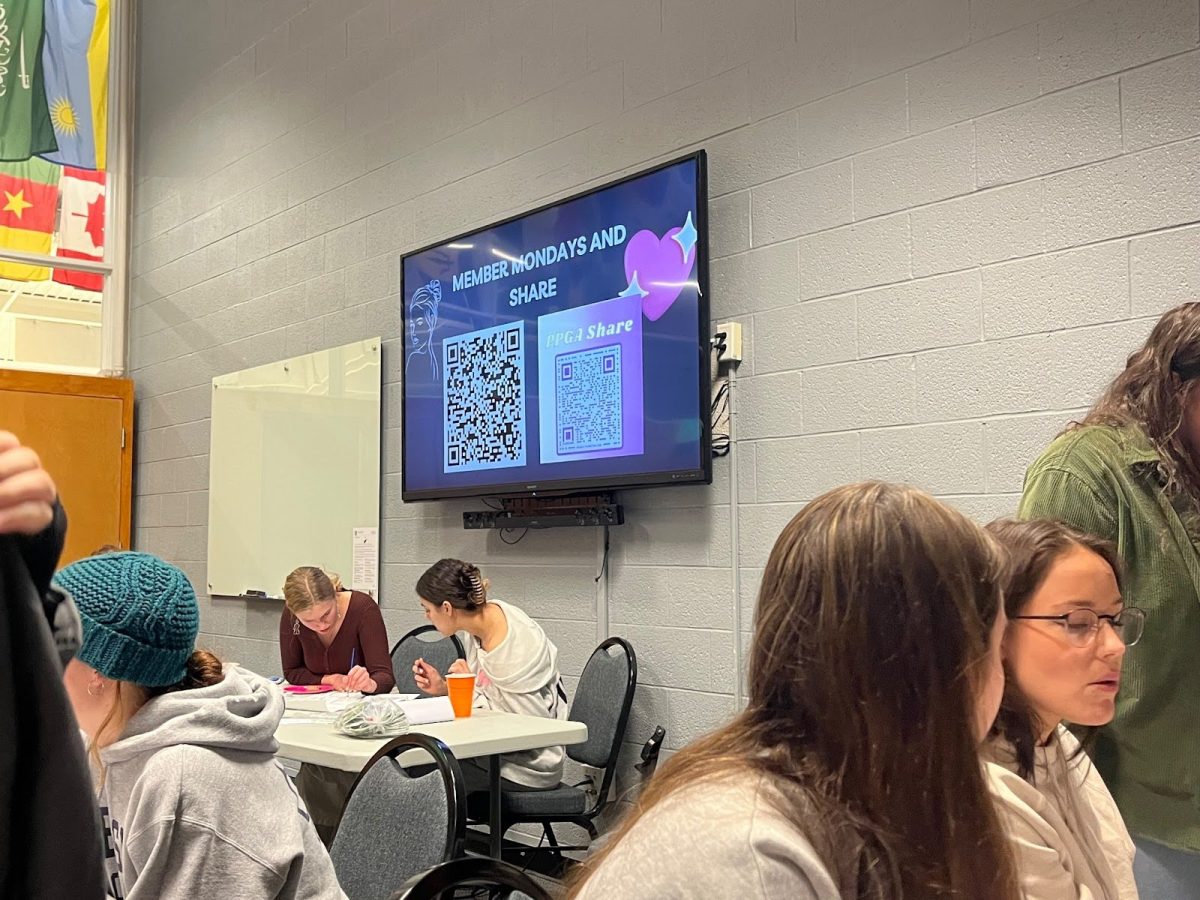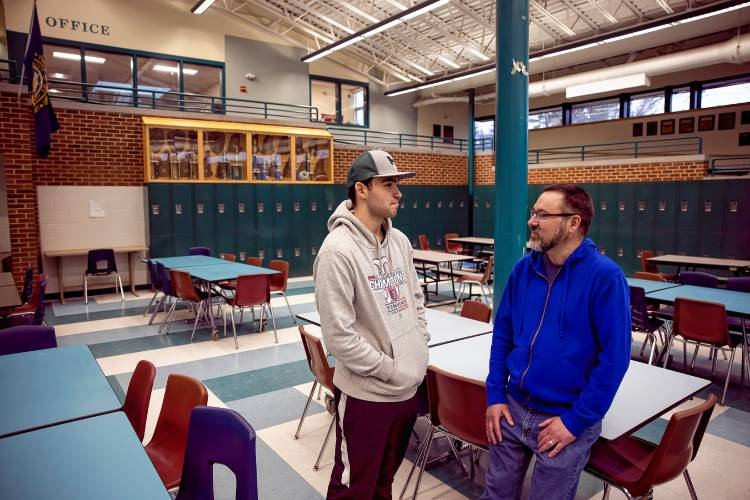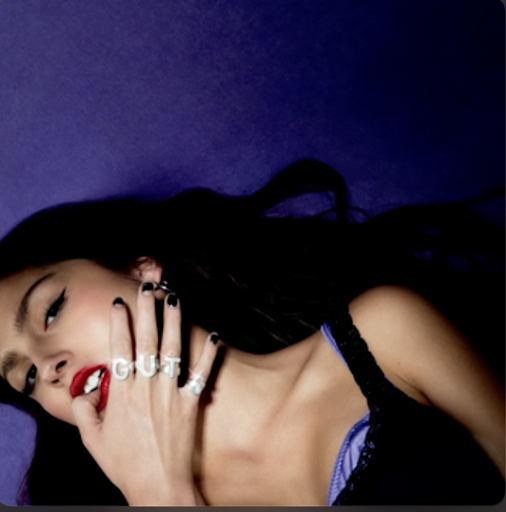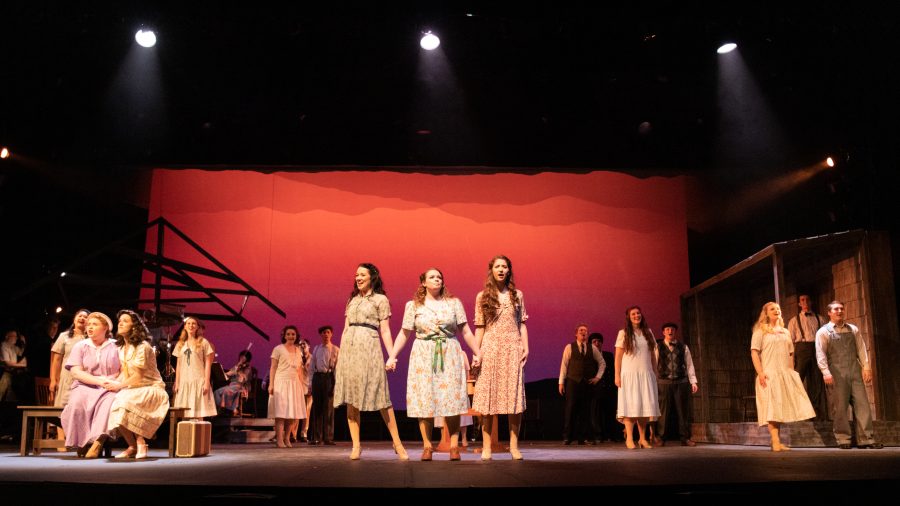Bluegrass music, dancing and lost relatives dominated the Johnson Theatre stage at the
Paul Creative Arts Center (PCAC) last week and into the weekend. The Department of Theatre and Dance (THDA), within the College of Liberal Arts, started their 2019-2020 performance season with the musical “Bright Star: An American Musical,” written by Steve Martin and Edie Bricknell. The musical featured 22 undergraduates as part of the cast, and many more students, staff and faculty behind the scenes.
An hour before the showing Friday at 7 p.m., the cast was in costume and stage makeup. Some members of the cast spoke with The New Hampshire outside the green room – named for its bright green walls – where they were finishing preparations. Call time, or the time they had been required to be in PCAC, had been 5:30.
However, spending many hours in PCAC was not anything out of the ordinary for the cast. Galen Graham, a sophomore theater and musical theatre major who played Billy Cane, explained the time commitment for the show.

“It was a little bit harder… This is what I expect to be spending my time doing, how we [musical theater students] want to be spending our time,” Graham said. The cast had started rehearsing August 27, and had rehearsed six days a week, four hours a day.
“It’s definitely worth it,” he added, calling the process “very fast-paced.”
Sophomore theater, acting and directing major Alex Natario, who played Daddy Murphy and a member of the ensemble, express a similar sentiment.
“We only have four or five weeks to get this show off the ground… we did it really well,” he said.
Rehearsal officially ran from 6 p.m. to 10 p.m. in the evenings with faculty and staff, though sometimes the cast stayed later. John Hopwood, a senior theater, acting and directing major and part of the ensemble, mentioned that there were times the students would continue rehearsing until midnight, or even 2 or 3 a.m.
Despite the time commitment, the actors’ excitement was evident.
“I’ve loved this show for a while,” senior theater, musical theatre and justice studies dual major Hannah Wagner, who played Margo, said. She mentioned that “Bright Star” was her favorite musical. “It’s a super, super fun show.”

In preparing for the show, the actors mentioned a unique element they had to deal with – dialect. The musical is set in North Carolina in 1923, 1924, 1945 and 1946; therefore, per Hopwood, to accurately portray their characters, the cast had to maintain a North Carolina dialect throughout the entire performance.
“We can have our lines and our music, but the dialect is equally as important too,” he said.
Senior theater and musical theatre major Amanda D’Amico played Alice, the star of “Bright Star,” and faced the added challenge of extensive stage time.
“It’s been challenging. I have a lot of lines as well as songs to memorize,” she said, noting that there were only four songs for which she was not on stage; the musical featured 24 songs in total.
“It’s been really rewarding… I feel like I’ve grown as a vocalist as well as an actor,” D’Amico said. To better develop Alice’s character, she focused on “using [her] vocal timbre,” to distinguish between young and older Alice, both of which she played. All actors played younger and older versions of their characters.
The actors encouraged students interested in getting involved in theater to look at the call-back board, located near room M-125 in the PCAC. The actors suggested auditioning for the small productions put on by student-run Mask & Dagger Dramatic Society; audition information for the 25th Annual Putnam County Spelling Bee was up with auditions scheduled for October 11. Hopwood stressed that the program welcomes all majors.
“We strongly encourage anybody and everybody to audition,” he said. As an example, Hopwood referenced a recently graduated student who had majored in sustainable agriculture and food systems and been part of THDA productions.
At 10 minutes to curtain, the actors finished preparations. As the box office printed out pre-bought tickets, the audience settled in their seats. Some had seats in the back half of the Johnson theater, but most of the audience filled in the front half.
Unlike a typical theater production, the curtain was raised before the show began. A five-piece band sat on stage right on a rustic-looking bandstand. The band was composed of local musicians – plus a member of the faculty – and provided all the instrumental sound for the show.
The band began playing as people gathered on stage. D’Amico’s Alice opened the show, walking to the front and singing “If You Knew My Story,” which set the tone for the rest of the show. Her dialect laid heavily but seldom obscured her singing which was at a lower timbre, since in this scene it was 1945 and her character Alice was older.
The show stayed in 1945 for the first few scenes, following Graham as Billy returning from World War II and deciding to bring one of his short stories to the “Asheville Southern Journal”, where Alice worked as an editor. He sang that he was going to “follow my own bright star” to the journal.
The Alice he encountered at the journal was curt, proper and wearing dark clothing, unlike the nervous 16-year-old Alice who went barefoot in 1923 in the following scenes.
The rest of Act I continued to jockey between 1923 and 1945, with most scenes featuring a balance of song and dialogue, while dry comedic lines sprinkled themselves throughout the act. Alice told Billy that his letter of recommendation for the journal was unacceptable, since it was from novelist Thomas Wolfe, who “died seven years ago.”
The audience applauded at each scene’s end. Emotions heightened in the later scenes of Act I, as young Alice discovers she’s was pregnant, and her father, with Natario as Daddy Murphy, signs her infant son over for adoption. Official adoption doesn’t occur though: the baby’s grandfather, Mayor Dobbs, throws the baby off a train, closing out Act I.
Act II opened in the style Act I had – no house lights flickered to indicate intermission was ending. The cast danced onto the stage. The first two scenes were in 1923 and 1924, and saw Daddy Murphy struggling with his decision to adopt out the baby. The baby’s father, Jimmy Ray Dobbs, learns what Mayor Dobbs had done. Mayor Dobbs, meanwhile, is struggling with karma, as liver disease wrecked his body and overwhelms him with his own anguish.
The rest of Act II stayed in 1945 and 1946. The audience cheered and laughed as Billy takes part in drunken antics with other editors from the “Asheville Southern Journal”, and when Billy equates kissing a girl to kissing a chicken.
Other scenes, however, possessed a more somber flavor to them, such as when Alice tries to find who had adopted her son and learns of Mayor Dobbs’ action. Daddy Murphy had mellowed with age and regretted what he had done, “23 years ago.”
In a later scene, Alice visits Billy’s homestead, and recognizes the gray baby sweater he finds. The audience held their breath as the characters reacted.
Equating him to a “little Moses in the rushes,” Daddy Cane explains how he had found infant Billy. The show concluded with Alice and the ensemble harmonizing in “So Familiar/At Long Last.”
Unanimously, immediately, the audience gave the cast a standing ovation, and remained standing as the cast sang “Finale,” grins lighting up their faces, Alice wearing a bright dress. The song ended, and the band played the audience out.





















